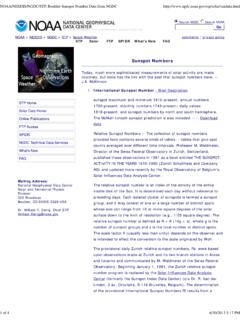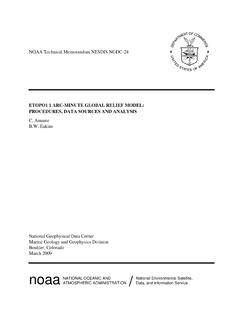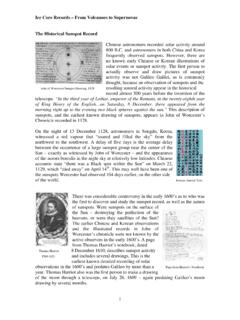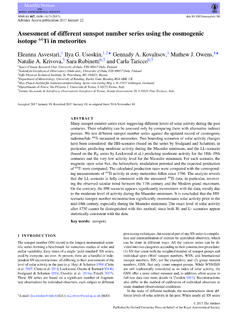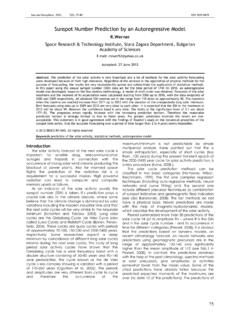Transcription of Readme: Sunspot Numbers
1 Under Development: 01 September 2013 (WFD) readme : Sunspot Numbers Today, much more sophisticated measurements of solar activity are made routinely, but none has the link with the past that Sunspot Numbers have ( McKinnon) Sunspot Numbers sunspots are temporary phenomena on the photosphere of the Sun that appear visibly as dark spots compared to surrounding regions. They are caused by intense magnetic activity , which inhibits convection by an effect comparable to the eddy current brake, forming areas of reduced surface temperature. They usually appear as pairs, with each Sunspot having the opposite magnetic pole to the other.
2 Although they are at temperatures of roughly 3000 4500 K (2700 4200 C), the contrast with the surrounding material at about 5,780 K (5,500 C) leaves them clearly visible as dark spots, as the luminous intensity of a heated black body (closely approximated by the photosphere) is a function of temperature to the fourth power. If the Sunspot were isolated from the surrounding photosphere it would be brighter than the Moon. sunspots expand and contract as they move across the surface of the Sun and can be as small as 16 kilometers (10 mi) and as large as 160,000 kilometers (100,000 mi) in diameter, making the larger ones visible from Earth without the aid of a telescope.
3 They may also travel at relative speeds ("proper motions") of a few hundred meters per second when they first emerge onto the solar photosphere. Manifesting intense magnetic activity , sunspots host secondary phenomena such as coronal loops (prominences) and reconnection events. Most solar flares and coronal mass ejections originate in magnetically active regions around visible Sunspot groupings. Similar phenomena indirectly observed on stars are commonly called starspots and both light and dark spots have been measured. (derived from Wikipedia) The Sunspot number (SSN) is a commonly used index of solar activity .
4 The daily Sunspot number was first introduced in 1848 by the Swiss astronomer, Johann Rudolph Wolf. His method, which is still used today, counts the total number of spots visible on the face of the sun and the number of groups into which they cluster, because neither quantity alone satisfactorily measures Sunspot activity . The relative Sunspot number is an index of the activity of the entire visible disk of the Sun. It is determined each day without reference to preceding days. Each isolated cluster of sunspots is termed a Sunspot group, and it may consist of one or a large number of distinct spots whose size can range from 10 or more square degrees of the solar surface down to the limit of resolution ( , 1/25 square degree).
5 The relative Sunspot number is defined as R = K (10g + s) where g is the number of Sunspot groups and s is the total number of distinct spots. The scale factor K (usually less than unity) depends on the observer and is intended to normalize the conversion to the scale originated by Wolf. The provisional daily Zurich relative Sunspot Numbers , Rz, were originally based upon observations made at Zurich and its two branch stations in Arosa and Locarn, Switzerland. Beginning January 1, 1981, the Zurich relative Sunspot number program was replaced by the Solar Influences Data analysis Center (SIDC).
6 The determination of the provisional International Sunspot Numbers Ri results from a statistical treatment of the data originating from more than twenty-five observing stations. These stations constitute an international network, with the Locarno station as the reference station, to Under Development: 01 September 2013 (WFD) guarantee continuity with the past Zurich series of Rz. The definitive International Sunspot Numbers , Ri, are evaluated by a similar method based on a network of observing stations selected for their high number of observations, their continuity during the whole year and an existing series of observations for past years.
7 Also taken into account is the stability of the K monthly factors with reference to the Locarno station. These relative Sunspot Numbers are now designated Ri (International) instead of Rz (Zurich). Monthly and yearly averages of the daily SSN are calculated in a straightforward manner. The daily Sunspot number has little, if any, relationship to ionospheric variability. However, the most widely used Ionospheric Index, R12, is derived from the daily Sunspot Numbers . The R12 index is a twelve-month smoothed relative Sunspot number . To calculate the R12 index for July 2010 add half of the Jan 2010 value plus the sum of the Feb through Dec 2010 values plus half of the Jan 2011 value and by divide the sum twelve: [(n1/2)+(n2+n3+.)]
8 N11+n12)+(n13/2)]/12 where n1 = Jan 2010, n7 = July 2010 and n13 = Jan 2011. Today, much more sophisticated measurements of solar activity are made routinely, but none has the link with the past that Sunspot Numbers have. AVAILABLE DATASETS Dataset: International Sunspot Numbers (1610 Present) Description The relative Sunspot number is an index of the activity of the entire visible disk of the Sun. It is determined each day without reference to preceding days. Each isolated cluster of sunspots is termed a Sunspot group, and it may consist of one or a large number of distinct spots whose size can range from 10 or more square degrees of the solar surface down to the limit of resolution ( , 1/25 square degree).
9 The relative Sunspot number is defined as R = K (10g + s), where g is the number of Sunspot groups and s is the total number of distinct spots. The scale factor K (usually less than unity) depends on the observer and is intended to effect the conversion to the scale originated by Wolf. Dataset Provider: Solar Influences Data analysis Center (SIDC), Royal Observatory of Belgium, Av. Circulaire, 3 - B-1180 Brussels Belgium. (POC: Frederic Clette) Daily Sunspot Numbers Tables; Listing (1818-Present) Monthly mean SSN Table; Listing (1749-Present) Year mean SSN Table; Listing (1700-2009) Smoothed monthly mean SSN Table; Listing (1749-Present) Dataset Status: Active Dataset: American Relative Sunspot Numbers (1944 Present) Description Dataset consists of tables and listings of the American Relative Sunspot number (SSN) provided by the American Association of Variable Solar Observers (AAVSO).
10 Tables include the daily relative SSN (RA from 1951 and RA before 1951) along with the calculated monthly and yearly means. Similarly, the listings are of daily RA and RA plus the monthly and years means. Beginning with 1951, the observations collected by the Solar Division, AAVSO, have been reduced according to a new procedure, such that only high quality observations of Under Development: 01 September 2013 (WFD) experienced observers are combined into RA'. Observatory coefficients for each of the 23 selected observers were recomputed on data for 1948-1950, years when there was a wide range of solar activity .
